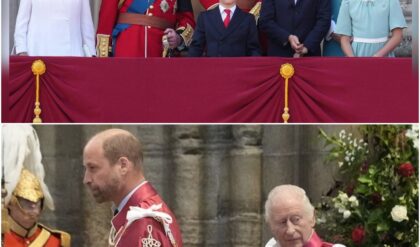
Many thanks go to Doug Banks and his team – the masters of colorization. The beauty of these colorized images is that color allows you to pick out and study the smallest detail. These are sights that our forefathers would have seen. Must have been strange for them to witness the war in color then to see it recorded in black and white.
Do not click on their page – you will become addicted to their work. It is the research that they do on each image that makes the captions themselves a history lesson. Facebook page here Colorized-Photos.
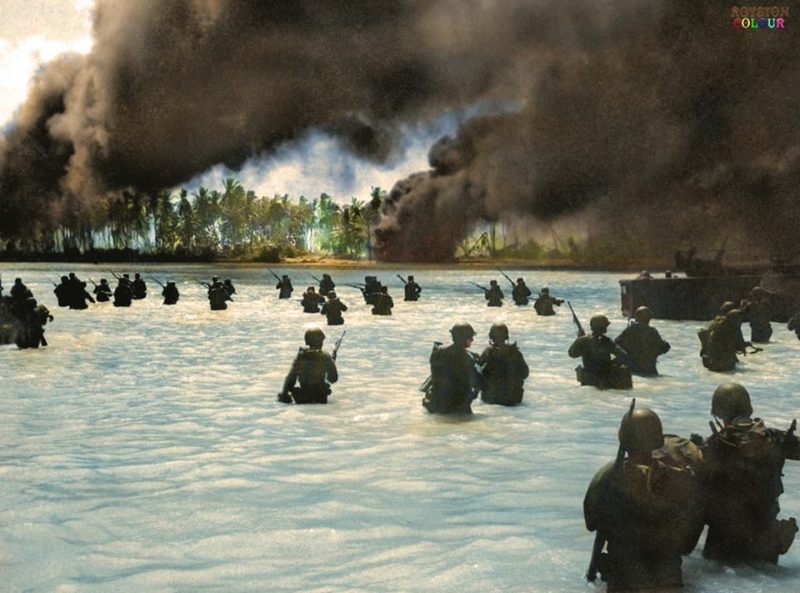
The Landings on Makin Atoll in the Gilbert Islands.
Assault troops of the US Army’s 2nd Battalion, 165th Infantry Regiment, 27th Infantry Division land on Yellow Beach on Butaritari Island at 1040 Hours, November 20, 1943
“Behind the tanks in the fourth and fifth waves came the troops of the 2d Battalion, l65th Infantry, boated in LCVP’s. Like the tank-carrying craft ahead of them, these too grounded on the reef. After a short hesitation, the men debarked into knee-deep water and began their slow passage into shore.
The intensity of fire from the enemy increased. Radios, flame throwers, bazookas, and other equipment were soaked or lost. In spite of the fact that the troops were fairly closely bunched in the water, they escaped with few casualties. Most of the fire was low in the water and inaccurate. Only two were killed; none wounded.”
(www.ibiblio.org) (Photo source – US National Archives) (Colourised by Royston Leonard from the UK)

An allied soldier takes advantage of the opportunity to have a bath in the port city of Tobruk, Libya. 17 February 1942.
During World War II, Allied forces, mainly the Australian 6th Division, took Tobruk on 22 January 1941. The Australian 9th Division pulled back to Tobruk to avoid encirclement after actions at Er Regima and Mechili and reached Tobruk on 9 April 1941 where prolonged fighting against German and Italian forces followed.
Although the siege was lifted by Operation Crusader in November 1941, a renewed offensive by Rommel the following year resulted in Tobruk being captured in June 1942 and held by the Axis forces until November 1942, when it was recaptured by the Allies. (Photo source – © IWM E 8439) No 1 Army Film & Photographic Unit – Lt. William G. Vanderson.
Online movie streaming services
Photographer Lt. William G. Vanderson became a Prisoner of War during the North African Campaign and was released from Oflag 79 in Brunswick, Germany at the end of the war. (Colourised by Doug)

A Soldier of the 535th Anti-Aircraft Artillery Battalion, 99th Infantry Division, with his pup during the Battle of the Bulge, somewhere in Belgium on January 4, 1945.
535th AAA AW (Anti-Aircraft Artillery Automatic Weapons) Battalion was part of the 99th Infantry Division which was known as the ‘Checkerboard Division,’ which referred to its shoulder patch.
The 99th Division first saw action on the 9 November, taking over the defense of the sector north of the Roer River between Schmidt and Monschau, a distance of nearly 19 miles. After defensive patrolling, the 99th probed the Siegfried Line against heavy resistance on 13 December. In late 1944 having not yet seen battle, it was nicknamed the ‘Battle Babies.’
The inexperienced troops of the division were lodged on the northern shoulder of the Ardennes Offensive on 16 December. Although cut up and surrounded in part, the 99th was one of the only divisions that did not yield to the German attack and held their positions until reinforcements arrived.
The lines were then moved back to form defensive positions east of Elsenborn Ridge on the 19th. Here it held firmly against violent enemy attacks. From 21 December 1944 to 30 January 1945, the unit was engaged in aggressive patrolling and reequipping. It attacked toward the Monschau Forest, 1 February, mopping up and patrolling until it was relieved for training and rehabilitation, 13 February.
(Colourised by Royston Leonard from the UK).
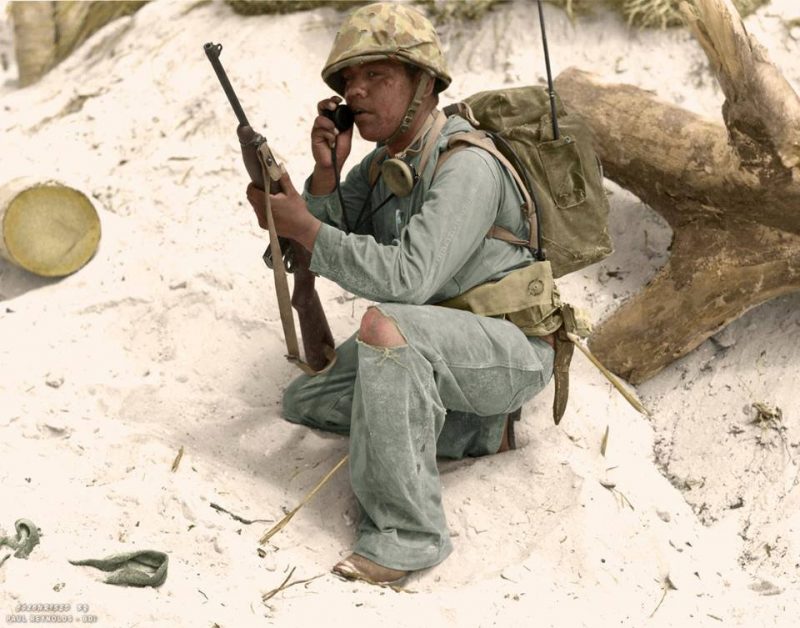
A US Navajo Marine communicating over his radio in the field of battle, Pacific theatre WWII.
Code talkers are people in the 20th century who used obscure languages as a means of secret communication during wartime. The term is now usually associated with the United States soldiers during the world wars who used their knowledge of Native American languages as a basis to transmit coded messages.
In particular, there were approximately 400–500 Native Americans in the United States Marine Corps whose primary job was the transmission of secret tactical messages.
Code talkers transmitted these messages over military telephone or radio communications nets using formal or informally developed codes built upon their native languages. Their service improved communications regarding speed of encryption at both ends in front line operations during World War II.
The name code talkers is strongly associated with bilingual Navajo speakers specially recruited during World War II by the Marines to serve in their standard communications units in the Pacific theater. Code talking, however, was pioneered by Cherokee and Choctaw Indians during World War I.
Other Native American code talkers were deployed by the United States Army during World War II, including Lakota, Meskwaki, and Comanche soldiers.
Post-war recognition:
The Navajo code talkers received no recognition until the declassification of the operation in 1968. In 1982, the code talkers were given a Certificate of Recognition by U.S. President Ronald Reagan, who also named August 14, 1982 as “Navajo Code Talkers Day.”
On December 21, 2000, the U.S. Congress passed, and President Bill Clinton signed, Public Law 106-554, 114 Statute 2763, which awarded the Congressional Gold Medal to the original twenty-nine World War II Navajo code talkers, and Silver Medals to each person who qualified as a Navajo code talker (approximately 300).
In July 2001, U.S. President George W. Bush personally presented the Medal to four surviving original code talkers (the fifth living original code talker was not able to attend) at a ceremony held in the Capitol Rotunda in Washington, D.C. Gold medals were presented to the families of the deceased 24 original code talkers.
On September 17, 2007, 18 Choctaw code talkers were posthumously awarded the Texas Medal of Valor from the Adjutant General of the State of Texas for their World War II service.
On November 15, 2008, The Code Talkers Recognition Act of 2008 (Public Law 110-420), was signed into law by President George W. Bush, which recognizes every Native American code talker who served in the United States military during WWI or WWII (with the exception of the already-awarded Navajo) with a Congressional Gold Medal, designed as distinct for each tribe.
The gold medals were to be retained by the Smithsonian Institution, and duplicate silver medals were awarded to each code talker or surviving family.
(Colourised and researched by Paul Reynolds.)

Two US Marines direct flame throwers at Japanese defenses that block the way to Iwo Jima’s Mount Suribachi, February 20 1945.
On the left is Pvt. Richard Klatt, of North Fond Du Lac, Wisconsin, and on the right is Pfc. Wilfrid Voegeli, from Kansas.
Pvt. Richard Adolph Klatt (left / Company ‘I’ Headquarters Platoon): KIA several days later. (1926 -1945) Aged 19. Pfc. Wilfrid Marcus Voegeli (right / 1st Platoon): Awarded a Bronze Star for his actions on Iwo Jima. (1925-2001).
Fellow Marine, Pfc. Jim Shriver serving as a BAR (Browning Automatic Rifle) man with Company ‘I’ of the 3rd Platoon (42 troops), 3rd Battalion, 28th Regiment of the 5th Marine Division (3/28). Jim and his unit went ashore in Iwo Jima on February 19, 1945 (D-Day) at approximately 1210.
On February 20th, 1945 (D+1) Jim Shriver was above and behind the two men is this photo, somewhat to the right, and maybe 20 or 30 yards back. Jim had his BAR trained and shooting on the opening of the cave where the two flamethrowers converged. Jim said that whoever took the photo must have been very close to him, but he didn’t see him.
John Overmyer, Pharmacist’s Mate (PhM) from the 2nd Platoon (since deceased), said he encountered Klatt just after his flamethrower had been struck and burst into flames.
John went into some detail, saying Klatt was horribly burned, and John was unable to do anything, even unable to pour water on his burns as he had used up all of his supply.
(Photo source USMC). (Colourised by Royston Leonard from the UK)

Messerschmitt Bf.109F-4/trop (W.Nr 10074) Gelbe 5 of 6 Staffel, Jagdgeschwader 27, piloted by Leutnant Gerhard Mix, Western Desert, Egypt. 14 August 1942.
It had made a forced landing in the rear of the Australian lines near El Alamein and was loaded on to a transport to be taken to RAF workshops to be examined by experts. Other German planes had tried to destroy it after it had landed, to prevent disclosing any secret technical developments. Lt. Gerhard Mix was uninjured and taken POW. This Bf.109 is camouflaged in RLM 78/79 with a typically undefined color demarcation line in the middle of the fuselage (but slightly lower than per standard).
Markings include white spinner and collar, white fuselage band and wing tips, and yellow lower cowling.
Number ‘5’ and the horizontal bar are yellow outlined in black. The squadron’s emblem of the ‘Berlin Bear’ is painted on either side of the cowling.
(Photo source -Australian War Memorial). (Colourised by Richard James Molloy from the UK). www.tig.uk.net
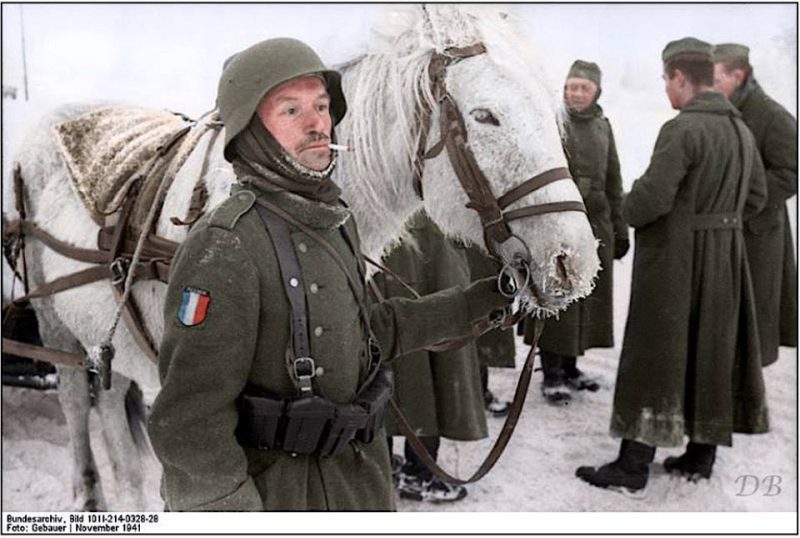
Légion des Volontaires Français (LVF)
Soldiers of the Wehrmacht French Volunteer Legion in Russia, November 1941.
The Légion des Volontaires Français (LVF), or Infanterie Regiment 638, as it was known to the Germans, was formed in July 1941. It was sent to Debica, Poland, for training and it remained there until October when it was sent to the Eastern Front attached to 7./Infanterie-Division. It suffered heavy losses during the Soviet winter offensive and the 2./Battalion was almost destroyed but a 3./ Battalion was formed from new volunteers (including some 200 Africans, mainly from Algeria).
After these losses it operated as individual battalions rather than as a single unit fighting the partisans. It continued fighting the partisans during 1943 but was once again used as a single unit when all the battalions were attached to 286. Sicherungs-Division.
It merged with Französische SS-Freiwilligen-Sturmbrigade in September 1944 to form the Waffen-Grenadier Brigade der SS Charlemagne. (source – axishistory.com). (Photo source – Bundesarchiv_Bild_101I-214-0328-28)
(Colourised by Doug)
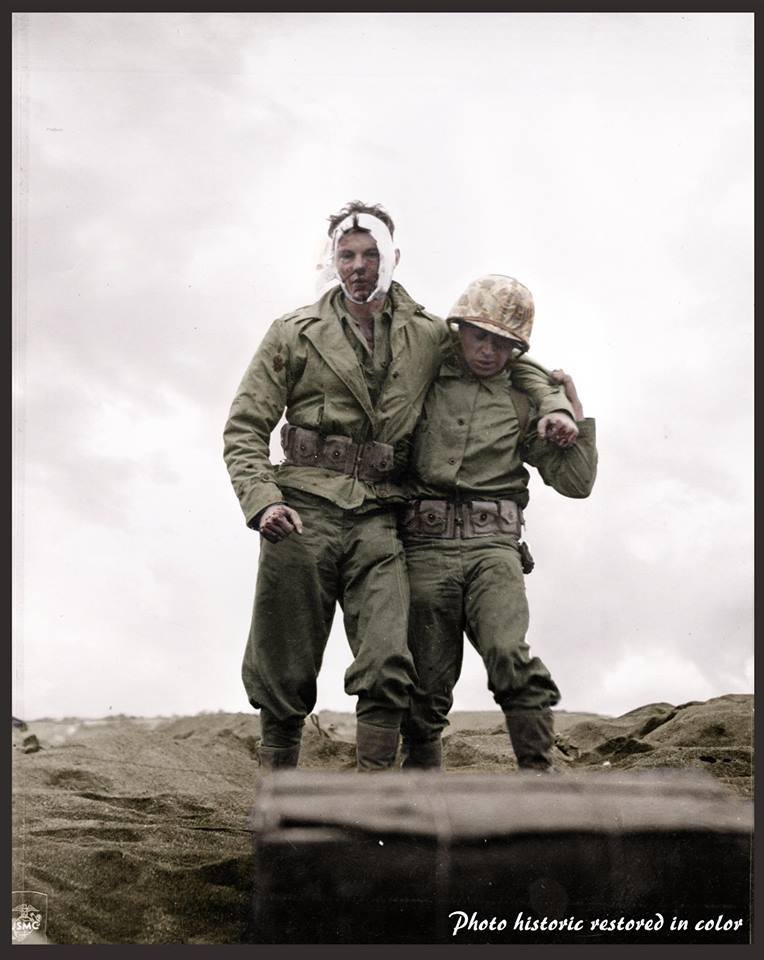
Nick Dalphonse and Robert ‘Plug’ O’Neil were cooks for the 23rd US Marine Regiment, 4th Marines Division, on Iwo Jima.
20th of February 1945 (D-Day+1) “……my head is killing me and this guy’s taking my picture”.
They had barely landed and the unit was constantly pinned down by enemy artillery, mortar, and machine-gun fire. A fellow Marine lost his composure and started popping off little bursts in all directions until O’Neil took his rifle. “It wasn’t bad enough that we could hardly move and then one of our leaders starts firing shots all over the place. We had to take his rifle from him.”
Not much after that, they found themselves under attack. They were concerned with the numbers of Japanese soldiers coming at them and noticed their 0.50 caliber machine gun had been taken out by enemy fire. The fire fights toward the front were intense and the machine gun seemed like the better option than the M1.
“They were in and on us. We were fighting and men were falling. At some point we noticed they had taken out our machine gun. The M1 was a good rifle and I know what they will teach you about shooting, but there will be nights when you go to sleep pretty sore. I swear we could pop guys off from behind the trees that were on those islands. We figured the only way we were coming off of that island was behind the machine gun, and just decided that it may as well be us. We moved the men and started firing that gun. The shells we were firing were half inch diameter. We were in a pretty good fight and lost a lot of good men there. Afterwards, we took it the rest of the way taking turns at it.
One evening we were firing the machine gun and that baby kept getting pretty hot.They just kept coming at us. All I can tell you is we were lucky our division was bringing along spare barrels.”
They also helped in repulsing several Banzai attacks that occurred toward the end of operations on the island. O’Neil and Dalphonse were machine gunners for the better part of the operation.
Nick also cornered a Japanese officer as they made their way through the brush. He ended up with his rifle on him. O’Neil was scanning flicking his eye toward his buddy. Nick said it seemed like forever, but he could see that the soldier was of some rank and thought he should be taken back for questioning. So they took him back to their field leader.
On Iwo Jima, heavy fire started as they made their way up the beach. O’Neil was hit by mortar fire and Nick bandaged and helped O’Neil back to the boat that would take him to the hospital ship. “There were shells flying all over the place and all of a sudden I saw ‘Plug’ running back with both hands on his face,” he added. “So I grabbed him, seen he was hit and took him back to the landing craft.”
Staff Sgt. Dalphonse ended up taking charge of the remaining men after losing their platoon leader.
Bob O’Neil account:
A mortar blast flipped him into the air, shredding his head and face.
He remembered spitting out blood and teeth as Nick Dalphonse crudely bandaged his head and helped him back to the shoreline to catch a boat to a hospital ship. Along the way, a Marine photographer snapped a picture of Dalphonse supporting his wounded, towering buddy.
Bob O’Neil’s wife, Betty, said her husband once told her how angry he was at being photographed at that moment. She recalled, “He said, ‘My head is killing me and this guy’s taking my picture?’ That’s why his hand is clenched in the picture.”
(The photographer was Corporal Eugene Jones, also of the 4th Division.) Robert O’Neil died in 2002 aged 78. Nick Dalphonse aged 91 in 2014 (and may still alive today).
(Colourised by Johhny Sirlande from Belgium).

Squadron Leader Brian J E “Sandy” Lane, the Commanding Officer of No. 19 Squadron RAF (facing the camera), relaxes with some of his pilots in the Squadron crew room at Manor Farm, Fowlmere, Cambridgeshire, UK. September 1940.
The chap on the left, with the scarf is, F/L Colin MacFie and the one with his back to the door is F/L Hugh “Cocky” Dundas, both from the visiting 616 Squadron. (Photo source – © IWM CH 1461). Royal Air Force official photographer – Devon S A (Mr).
(Colourised by Royston Leonard from the UK)
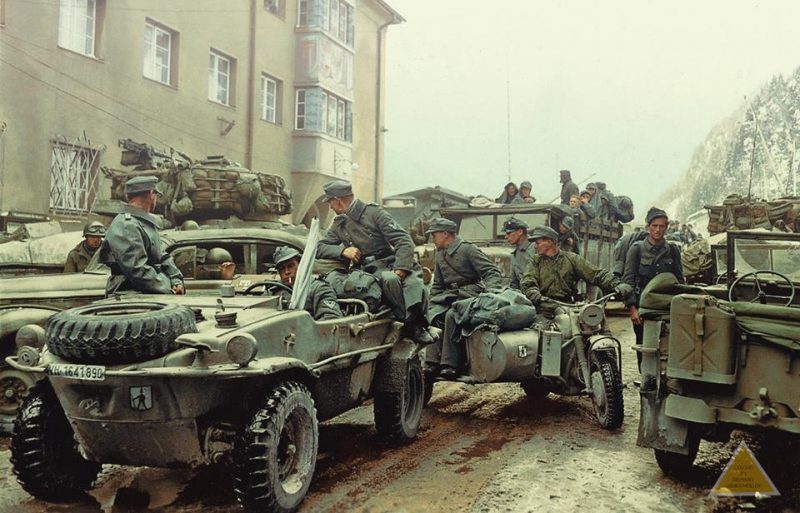
A Surrendered Schwimmwagen Kfz1 Type 166 (WH 1641890) and a BMW 75 Motor bike & side car with other vehicles of the 278. Infanterie Division (Wehrmacht) at the Brenner Pass, on the Italian – Austrian Border. May 1945.
(The 278 I.Division emblem was a black figure of a Pomeranian Grenadier holding a musket bordered by a shield). The 278.ID were manning defence fortifications near the Brenner Pass. It surrendered to the 5th and 7th US Armies in May 1945. It was originally assigned to LXXVI Panzer Corps defending the Gothic Line, and after heavy losses the 278th was formed into a Volksgrenadier Division in early 1945. It was later transferred to 1.Fallschirmjäger, defending the Brenner Pass where most of the Division was encircled, the remainder later surrendered on the May 2, 1945.
(Colourised by Richard James Molloy from the UK)

As a rocket-firing LCI lays down a barrage on the already obscured beach on Peleliu, a wave of Alligators (LVTs, or Landing Vehicle Tracked) churn toward the defenses of the strategic island September 15, 1944.
The amphibious tanks with turret-housed cannons went in after heavy air and sea bombardment. Army and Marine assault units stormed ashore on Peleliu on September 15, and it was announced that organized resistance was almost entirely ended on September 27.
Operation ‘Stalemate II’ – The Peleliu operation was code-named Stalemate II, a name that seems ironic in hindsight, because initially the campaign was viewed with relative optimism. The main task of securing the island was given to the 1st Marine Division, a largely veteran unit that had seen action at Guadalcanal and New Britain. The 1st Marine Division consisted of the 1st, 5th, and 7th Marine Regiments (infantry) and the 11th Marines (artillery support).(AP Photo).
(Colourised by Royston Leonard from the UK)

North American P-51 Mustang “Fools Paradise IV” (tail Nº 413309) of the 380th Fighter Squadron, 363rd Fighter Group, 9th USAAF at Maupertuis Airfield near Cherbourg in France. July/August 1944.
Evan M. ‘Mac’ McCall was the squadron commander and also attached to Patton’s 3rd Armored Division as a jeep-mounted Forward Air Controller on the ground in France. (Note, we have been unable to confirm the correct color and content of the jeep ‘canvas cover – art work’ but have used our knowledge of WW2 US aircraft ‘nose art’ to arrive at these colors. If anyone can help identify the colors or the name written on the canvas, please message us).
(Colourised by Benjamin Thomas from Australia).
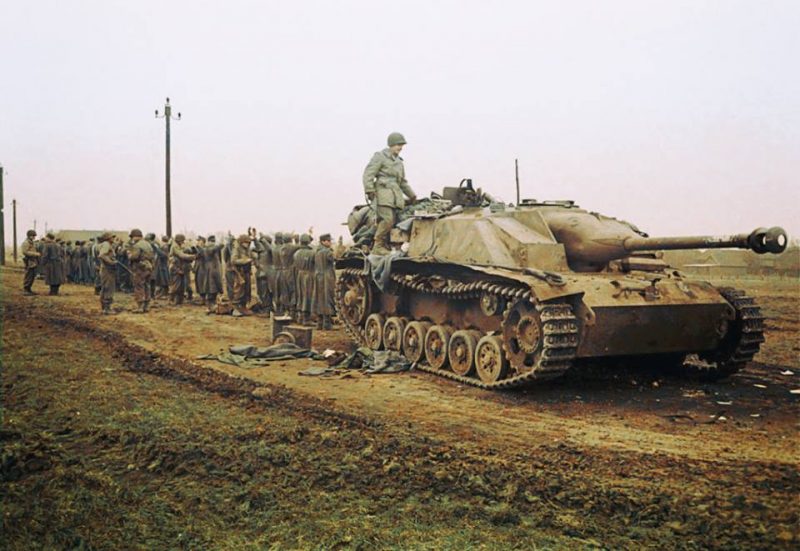
“Abandoned assault gun Sturmgeschütz StuG III Ausf G and German prisoners of war in Ruhr, Germany. February 1945.”
Not a lot of information on this one but the interest is the ‘nose art’ on the Topfblende pot mantlet (often called Saukopf “Pig’s head”) added by the crew or maybe by Allied soldiers.
(Colourised by Richard James Molloy from the UK)

Flight Lieutenant John Pattison of No. 485 (NZ) Squadron RAF, graphically recounts a combat to Squadron Leader Reginald Grant, and Flight Lieutenant Reginald Baker (‘A’ Flight Commander), in front of a Spitfire Mk Vb at RAF Westhampnett, West Sussex. 21 January 1943.
F/Lt Pattison from Waipawa, had flown with Nos. 92 and 266 squadrons during the Battle of Britain; he was shot down by a Bf 109 in September 1940 and severely wounded, he recovered to have a distinguished war, being awarded a DSO and a DFC. he died in 2009 age 92. S/Ldr. ‘Reg’ Joseph Cowan Grant DFC & Bar, DFM from Woodville Nth Island, was appointed Wing Commander Flying of 122 Wing, equipped with Mustangs in early 1944.
On 28 February 1944, Grant took off for a sortie across the English Channel. Shortly after take off, in cloud, the engine of his fighter cut out. After ordering the wing to carry on without him, he turned back to base. On coming out of cloud at 1000 feet, he baled out but was too low for his parachute to open properly and fell to his death.
Reginald William Baker from Dunedin, was Commanding Officer, 487 Squadron RNZAF (flying Mosquito – 6 operations).
On February 22 1945, he was killed in action when his aircraft carried out an armed reconnaissance over the Hamburg-Bremen coast area and was one of two Mosquitoes shot down NW of Hamburg, crashing near Bevern, seven km East of Elmshorn at 13:15 hrs.
(Photo source – © IWM CH 8385). Royal Air Force official photographer – F/O Watkins

Reichsmarschall Hermann Göring’s Mercedes 540K with an armored body and bulletproof glass at Berchtesgaden, Germany.
Behind the wheel is 1st Sergeant Owen E. Henderson, and 1st Lieutenant James Cox both of ‘C’ Company, 326th Airborne Engineering Battalion of the US 101st Airborne Division.
On May 4, 1945, the 101st Airborne Division ‘Screaming Eagles’ liberated and took possession of this armored 1937 Mercedes Benz 540 K Spezial Roadster at Berchtesgaden in the Bavarian Alps. The car had been custom made for Hermann Goring.
US Major General Maxwell Taylor used this Mercedes as his command car in Germany until it was commissioned by the US Treasury Dept, in Washington DC to be displayed on a Victory war bond fund-raising tour across the USA. The bond tour was very successful.
In 1956 the car was auctioned off by the US Army at the Aberdeen Proving Grounds in Maryland, sold to Jacques Tunick of Greenwich, Connecticut, with a high bid of $2167. In 1958, he sold it to the private collection of veterinarian Dr. George Bitgood, Jr, who had it repainted into black and the chrome re-plated. Kept private, Bitgood only displayed it once at the 1973 county fair in Durham, Connecticut.
After Dr. Bitgood’s death, “Blue Goos” was shown by his family at the 101st Airborne Reunion at Fort Campbell, Kentucky in June 2002. The car was then sold to Carnlough International Limited of Guernsey, on the agreement that she be restored to her “as found” at Berchtesgaden condition.
(Colorized by Patty Allison from the USA)
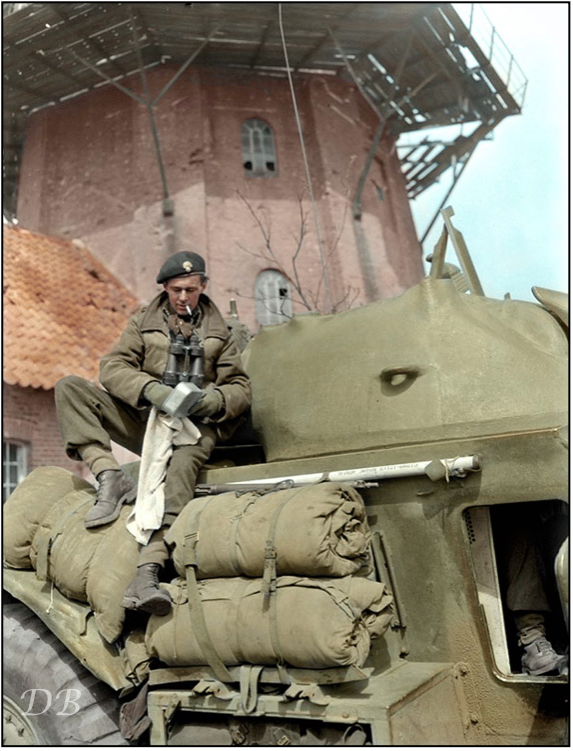
“Sergeant I.F.Chase cleaning his mess tin on a General Motors T17E1 Staghound armoured car of the South Alberta Regiment, 4th Canadian Division, Bad Zwischenahn, Germany, 29 April 1945 “
We think:- This soldier is wearing a Canadian Grenadier Guardsman cap, and the CGG captured Bad Zwischennahn with the 18th Armoured Car Regiment (12th Manitoba Dragoons). Therefore the Staghound may belong to them and not the Sth. Alberta Regt.
“……the South Alberta Regiment had tried to cross the Aue River to beat the 2nd Division into Oldenburg, losing five Shermans, four Stuarts and an armored ambulance in fighting between 15 and 19 April but nonetheless beating their way through scattered infantry resistance. The loss of a Valentine bridge-laying tank to a mine ended the drive on Oldenburg. An opportunity lost that was described later as the Commanding Officer’s “greatest disappointment of the war.”
Feeling marooned, the SAR was beyond the range of friendly artillery, save that of some medium batteries, and adapted one of its squadrons to fire the 75mm guns of its Shermans indirectly in support of the other two squadrons. The C.O. organized another troop of engineers to augment the existing troop, and laid hands on a company of The Lincoln and Welland Regiment, as well as a squadron of Staghound armored cars from the 18th Armoured Car Regiment and a troop of M-10 self-propelled guns, all in order to help make the regiment self-sufficient.
When the advance continued on 17 April, the SAR had a 12-mile front to cover, and a new bridge-layer got them across the Aue. Another river, the Lethe, had to be bridged on the 19th. Resistance stiffened and scattered fighting in front of Oldenburg lasted until 24 April, the last heavy day of fighting the regiment encountered during the Second World War.
The attachments from the Lincoln and Welland and the Manitoba Dragoons were withdrawn, and the GOC of 4th Canadian (Armoured) Division refused an appeal by the C.O. for infantry – there was none to spare. The SAR were ordered simply to maintain contact with the enemy, which meant advancing through craters, mines, and booby-traps after the Germans decided to withdraw from their positions.
On the left of the 4th Armoured Brigade, the 18th Armoured Car Regiment (12th Manitoba Dragoons) drove to the northwest in the direction of Godensholt. Brigadier Moncel remarked that the roads prevented more than two squadrons of tanks from deploying simultaneously, only one troop of each being able to fire directly at the enemy. Tactics revolved around finding company objectives 200 yards apart, with attacks supported by single troops of tanks, no more sophisticated than simply driving straight forward onto the objective. They were aided, however, by good coordination with air support.
German resistance on the approaches to Bad Zwischenahn remained fierce despite their own losses (3,600 prisoners were added to 4th Division POW cages in April).” (Photo source – (Lieut. Christopher J. Woods / Canada. Dept. of National Defence / Library and Archives Canada / PA-144148).
(Colourised by Doug)

Captured German PzKpfw V ‘Panther’ Tank, rolling along a dirt road in Northwest Europe and used here by the 4th Coldstream Guards, 6th Guards Tank Brigade, 29 November 1944.
One of the best-documented cases is that of the Panther renamed ‘Cuckoo.’ The tank was found abandoned in a barn during the fighting for the village of Overloon. Before its capture, the tank had belonged to the 2./Panzer Brigade 107. The British tankers assigned ‘Cuckoo’ to the 4th Battalion Coldstream Guards alongside their issued Churchills, apparently to a staff section. These staff tanks were all named after birds, such as Eagle and Vulture; hence, the name ‘Cuckoo.’ In preparing the tank for its new owners, a new coat of paint was applied, most likely the same khaki as the Churchills. Cuckoo’s new operators were impressed and happy with their acquisition; in particular, they admired the high quality of the optics in the tank’s sights, something for which the Germans were noted.
‘Cuckoo’ participated in the attack on Geijsteren Castle and then took part in Operation Blackcock in January 1945. This attack was designed to push the Germans out of a triangular area of ground between the Dutch towns of Roermond, Heinsburg, and Sittard. ‘Cuckoo’ was employed in an attack on the town of Waldenrath in the southeastern corner of this triangle. The winter was harsh, and icy conditions made for difficult going. ‘Cuckoo’ both impressed and angered its new owners. While the Churchill tanks seemed to constantly slide and become stuck on the icy roads, the Panther kept moving with absolutely no problem at all, oblivious to the conditions plaguing the British armor.
The tank was used again during Operation Veritable, a campaign designed to clear the area between the Roer and Rhine Rivers in Germany. During this operation, the British were involved in heavy fighting in the Reichswald, which was forested and inhospitable terrain for tanks. Nevertheless, ‘Cuckoo’ fought here for its new owners. Unfortunately, during this campaign, the Panther’s fuel pump failed and could not be fixed or replaced. Abandoning the tank, the Coldstream Guards went on to finish the war with their Churchills. (warfarehistorynetwork.com).
(Photo source – © IWM B 12187) No 5 Army Film & Photographic Unit – Sgt. Laing.
Online movie streaming services
(Colourised by Gabriel Bersanu from Romania)

Flexible Gunner, Sergeant Leo Frank Teetman from Brooklyn, New York with the 384th Bomb Group, 547th Bomb Squadron, enjoys a sandwich and coffee whilst waiting to be de-briefed at Kimbolton, Cambridgeshire, England. 1 January 1944.
31 December 1943: mission
Target: Blockade Runner ‘ORSONE’ (name of ship)
Target type: Transportation
[Mouth of River Garonne], France
Target not found: The 384th Bombardment Group (H) flew as the low group of the combat wing of today’s mission. The primary target was reported to be at or near the mouth of the river Garonne, which rises in the Pyrenees mountains and flows generally northwestward, through Bordeaux, and empties into the Bay of Biscay. However, the target not seen due to 10/10 Cloud cover, while the secondary target was hidden by 8/10 clouds, so the formation returned without attacking. Bombs were mostly jettisoned in the English Channel. Due to weather and fuel shortage, most aircraft landed at other bases.
B-17F (41-24578)’ORSONE’ landed away at Kimbolton with bomb load. Leo Teetman was born in Brooklyn to parents of Polish descent and lived most of his life on the East Coast. He joined up in 1942 and was assigned as a gunner to the 384th Bomb Group, 547th Bomb Squadron, based at Grafton Underwood in Northamptonshire, UK.
Leo completed 25 credited missions in the early stage of the bombing campaign when the USAAF’s focus was on Occupied Europe.
After the war, Leo settled in Connecticut, where he worked for a company making optical instruments. He married and had three children. Leo Frank Teetman (1922 – 1999).
(Colourised by Doug)
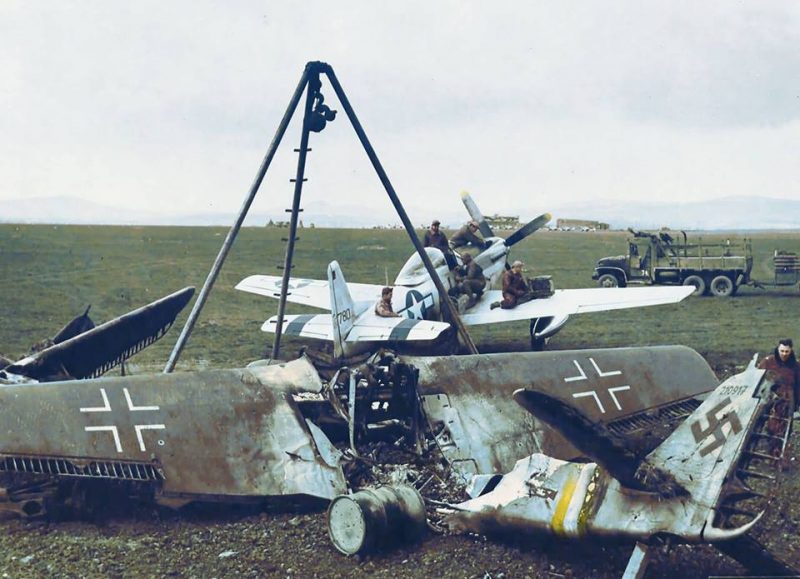
A North American P-51D ‘Mustang’ (s/r. 44-63780) of the 354th Fighter Group, 356th Fighter Squadron, USAAF, at Ober-Olm airfield (code Y-64), a district in the east of Mainz-Bingen, Rhineland-Palatine, Germany, early April 1945.
Around 8 April 1945, when the 345th FG moved to Ober-Olm. In the foreground is the wreck of Focke-Wulf Fw 190D-9 (W.Nr. 210917). It was produced in December 1944 and seems to have been blown up by the retreating German troops or P-47 Thunderbolts from a previous raid. (Official US Air Force photo no. 080 307-f-3927O-037).
(Colourised by Richard James Molloy from the UK).
www.tig.uk.net

2nd Lt. Kenneth E. Neidigh of 355th Fighter Squadron, 354th Fighter Group displaying a German Swastika flag.
He was shot down over Witzenhausen, Hesse in Germany on 31 Mar 1945 and taken prisoner; he later escaped on 10 April when American forces approached the prison camp. (pic was taken 17 April 1945). Kenneth Edwin Neidigh from Spokane County, Washington.
27 September 1923 – 4 March 2006.
(Colourised by Richard James Molloy from the UK)
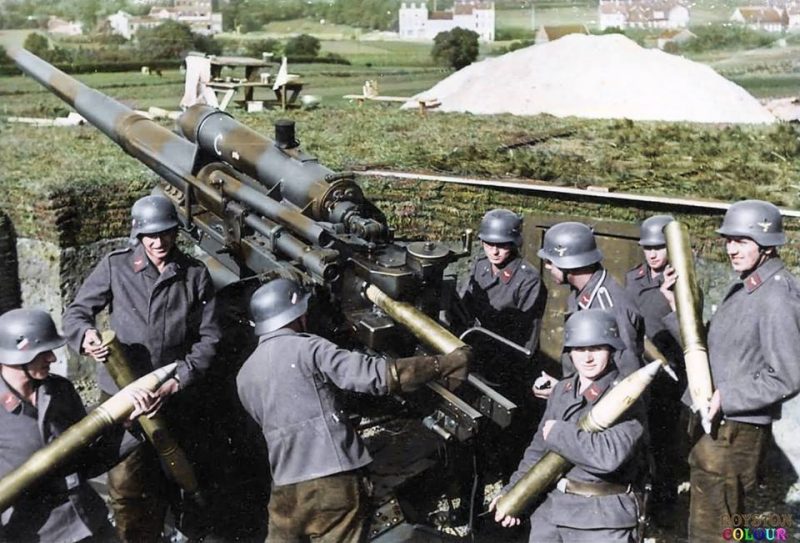
8.8cm FlugzeugAbwehrKanone (FlaK) 18/36/37.
The 88 mm gun (eighty-eight) was a German anti-aircraft and anti-tank artillery gun from World War II. It was widely used by Germany throughout the war, and was one of the most recognized German weapons of the war. Development of the original models led to a wide variety of guns.
The name applies to a series of guns; the first one officially called the 8.8 cm Flak 18, the improved 8.8 cm Flak 36, and later the 8.8 cm Flak 37. Flak is a contraction of German Flugzeugabwehrkanone, meaning “aircraft-defensive cannon,” the original purpose of the eighty-eight. In informal German use, the guns were universally known as the Acht-acht (“eight-eight”), a contraction of Acht-komma-acht Zentimeter (“8.8 cm”). In English, “flak” became a generic term for ground anti-aircraft fire.
The versatile carriage allowed the eighty-eight to be fired in a limited anti-tank mode when still on wheels, and to be completely emplaced in only two-and-a-half minutes. Its successful use as an improvised anti-tank gun led to the development of a tank gun based upon it. These related guns served as the main armament of tanks such as the Tiger I: the 8.8 cm KwK 36, with the “KwK” abbreviation standing for KampfwagenKanone.
In addition to these Krupp’s designs, Rheinmetall created later a more powerful anti-aircraft gun, the 8.8 cm Flak 41, produced in relatively small numbers. Krupp responded with another prototype of the long-barreled 88 mm gun, which was further developed into the anti-tank and tank destroyer 8.8 cm Pak 43 gun, and turret-mounted 8.8 cm KwK 43 heavy tank gun.
(Colourised by Royston Leonard UK).











